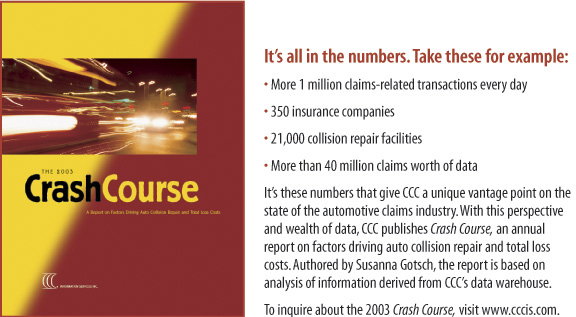
| industry insights | |
| introduction | |
| features | |
| departments/columns | |
| Industry Trends | |
| Perspective | |
| Guest Perspective | |
| Interview | |
| Interview | |
| CCC News Wire | |
| who we are | |
| archives | |
| CCC UpFront home |
| industry trends |
| Throwaway Vehicles |
| By Susanna Gotsch |
|
More and more, the collision repair industry is being run on data. Data helps us understand industry trends and better prepares us for what lies ahead. Each year, CCC Information Services Inc. publishes the CCC Crash Course, a comprehensive look at the previous yearıs data and what it might tell us about the future. Some of last yearıs more telling trends are explored below. The automobile industry is rife with innovation. Car manufacturers are rolling out the latest and greatest technologies like never before. More vehicles are being built with high strength steel and aluminum, while the use of tailored blanks and tubular hydroforming is becoming common in state-of-the-art vehicle construction. There are also new consumer-oriented features such as airbags, hid or xenon lighting, telematics, and collision avoidance/warning technologies. In 2003, cars rolled off the assembly line safer- and more complex - than ever before. Although primarily deployed to create safer and more appealing automobiles, many of these new technologies have a tremendous impact on vehicle damageability and reparability. They can affect how a vehicle is repaired, how much it will cost to repair, and to some degree, whether it makes economic sense to repair the vehicle at all. This impact is reflected in the growing number of lines per repair appraisal. Over the past several years, the average number of lines per appraisal has steadily increased, from 27.5 lines in 2000 to 30.5 lines in 2003 - an 11 percent increase. It is likely the number of lines per appraisal will continue to rise. As automobile manufacturers attempt to reduce production costs by sharing vehicle platforms - body frames, chassis, etc. - across multiple vehicle models, new technologies will help them to differentiate appearance, performance, fuel economy, and in the end, consumer perception. Consumer perception and changing demands are the forces driving original equipment manufacturers (oems) to work harder than ever to respond even faster. And, theyıre looking to innovation to get them there. The emergence of 'crossover vehicles'- a combination of select features from cars and light trucks - is a perfect example of how oems who met customer needs gained market share. These vehicles were among the hot new sellers in 2003. Oems, however, must look beyond innovation as simply a means to expand market share. To have genuine success, they must understand the impact that innovations have on the complete vehicle-ownership cycle. After all, if vehicle-repair costs continue to rise, while residual values decrease, the percentage of vehicles that are deemed a ³total loss² will steadily grow. New automotive innovations resonate far beyond consumers and the manufacturers that sell them their cars. Those same innovations are forcing the collision repair industry to keep pace and learn repair techniques for new, increasingly sophisticated features. Moreover, repairers face the challenge of finding ways to minimize the natural escalation in repair costs. New Vehicle Sales Although vehicle sales were one percent below 2002 levels, the 16 million-vehicle number has long been a benchmark for the industry. Predictions for 2004 new vehicle sales vary from 16.7 to 17.1 million, which if correct, will be a slight increase over 2003 sales. Analysts have pointed to multiple factors in predicting growth in new vehicle sales, including continued economic growth, low inflation, low interest rates, rising employment and increased personal income.1 Used Vehicle Sales As vehicle quality has improved, cars are staying in operation longer than before. Nearly 60 percent of 1986 model year vehicles are still in operation today. With longer vehicle life comes a higher probability of turns in ownership, as many as three or four times in a vehicleıs lifetime. Although nearly new vehicles account for a decreasing share of the used-vehicle market, sales of older vehicles increased in 2003 because of the slow economy. However, based on the decrease in new-vehicle leasing, the supply of used vehicles is expected to shrink further in 2004 and 2005. In 1999, 32 percent of all new-vehicle transactions were leases. In 2003, leasing accounted for only 20 of new vehicle transactions. Leasing has declined as attractive incentives have coaxed consumers to buy new cars versus leasing or purchasing late-model used cars.3 FOOTNOTES
Susanna Gotsch is director of analysis and reporting at CCC Information Services Inc., and author of Crash Course. |

